Martin Patrick – 17 February, 2014
Taken together, the exhibition has a resonant synchronicity as each of the three artists investigates aspects of monumentalizing (in heavily stylized ways) the everyday. Sometimes this occurs by scrutinizing the banal and making it strange, but also in a peculiarly insistent fashion, looking hard at the potentially outlandish or weird, and bringing it close to hand, making it tangible, legible, smaller and oddly reassuring.
Wellington
Laurence Aberhart, William Eggleston, Noel McKenna
South of No North
14 December 2013 - 9 March 2014
The artists in South of No North emerged from three entirely different cultural contexts. Yet, taken together, the exhibition has a resonant synchronicity as each artist investigates aspects of monumentalizing (in heavily stylized ways) the everyday. Sometimes this occurs by scrutinizing the banal and making it strange, but also in a peculiarly insistent fashion, looking hard at the potentially outlandish or weird, and bringing it close to hand, making it tangible, legible, smaller and oddly reassuring. Of course the two photographers Aberhart and Eggleston both have photographed in some of the same regional territory, the former on a Fulbright fellowship to the United States in 1988, the latter for most of his long career. Something nags at me that I would dearly love to see Eggleston closely observe New Zealand in the way he does the surroundings of Memphis, Tennessee, perhaps because so many of Aberhart’s photos in Taranaki or elsewhere in Aotearoa might have been taken in some middle American hinterland, such as in his image which records the phrase “death to disco”: spastically tagged graffiti onto a plain shed wall.
The American photographer William Eggleston’s work is very well known to me but I always get a charge out of examining his almost obscenely saturated dye-transfer prints (a cost prohibitive, lush, and archival method) and their correspondingly stark iconography: a looming tricycle, a few Quaker State motor oil cans left amidst some muddy tyre tracks, strands of Christmas lights draping around a green painted pole in a strip-mall parking lot, a beat-up football-themed pinball machine glowing in the afternoon sun. (His photo of a bare bulb on a blood red ceiling or a Confederate flag turned neon sign would be identifiable to some for their use as album cover art for the bands Big Star and Primal Scream, respectively.) Eggleston gained considerable renown back in 1976 as the first major fine art photographer to exhibit colour works in the Museum of Modern Art, with an accompanying book that is a classic of its type, entitled William Eggleston’s Guide. Most of the works in the current show draw upon both the Guide and his 1980 series Troubled Waters.
These days Eggleston often surfaces as a grumpy, frequently inebriated, mumbling lion in a plethora of documentaries that offer awkward tribute to this major artist. Eggleston loves to pare his remarks down to the Minimalism of a Modernist Zen koan: “only one picture of any one thing,” and is generally not a very garrulous (or comprehensible) interview subject. But his photographs are nearly always bold and arresting, as is the video work also on view Stranded in Canton, mostly shot in the nightclubs and bars of Memphis in the early 1970s, featuring a range of of imminent casualties of uninhibited hedonism; a must-watch time capsule of a bygone moment, eerily shot in black and white infra-red style video.
Aberhart is one of New Zealand’s most eminent photographers and his images, generally shot with large format cameras on black and white negative film, are more often than not, just as intense in their more subdued manner as Eggleston’s lurid hallucinations. He is similarly interested how nature and culture uneasily negotiate and contend with one another, as Mt. Taranaki is viewed past, and framed by, the lights of a New Plymouth suburb. A truck parked against a lit motel billboard is reflected in a nearby puddle. Again spare compositions offering rich tonality and detail, as Aberhart focuses his viewpoint on a lone light dangling from a powerline. Aberhart when he voyaged in the US spent most of his time in the South, visiting the juke joints and clubs of Texas, Louisiana, and Mississippi. His photos taken there are frontal, head-on, inclusive, owing a debt to the legacy of Walker Evans. Aberhart displays a dry humour as well, recording a pathetically shabby “Photos While-U-Wait” booth, a furniture store advertising La-Z-Boy recliners, the sign of a makeshift church announcing: “prayer works, try it.” According to an informative curatorial wall text: “Aberhart and his family travelled cheaply staying in socially impoverished, and for the most part African American parts of town. Once they began talking to people and their background was established, ‘We weren’t white American trash and [more especially New Zealand-ers]’ they gained valuable cultural insights: ‘The words would flow-basically about what a bitch of a racist world they lived in.’”
I hadn’t seen the works of Australian painter Noel McKenna prior to this occasion and they are knockouts. I’m completely captivated by the artist’s microworld based on a deceptively clunky, cartoonish style of rendering children, animals, lone figures, vernacular architecture, including kitsch monuments: gigantic penguins and rocking horses, pineapples and oranges. Initially having the flavour of “outsider” art, once it hooks you in, the complexities and range of McKenna’s style become more evident. Minimal compositions depict stark spaces and environments, often devoid of much to see, but they are then flattened and distorted in a fascinating way, as my own impressions of them moved back and forth between dreamlike and depairing, childlike and knowing. Simply painted houses loom as macabre, twilit temples. A boy (inspired by the artist’s son) dressed as Batman pounces before us. I also enjoyed tremendously a vitrine showcasing McKenna’s small tiles, featuring paintings of single household objects: tools, a paintbrush, a measuring tape. McKenna’s paintings, which feature close analysis of the often overlooked are perfect company for the photographs of Aberhart and Eggleston. And across the way in City Gallery, in an adjacent room are Erica van Zon’s sculptures conjuring entrancing objects based on those mentioned in the works of writers Truman Capote and Joan Didion. Thus one could say that there is a kind of Southern (Hemisphere) Gothicism lurking around the local public art gallery. Well worth a visit.
Martin Patrick
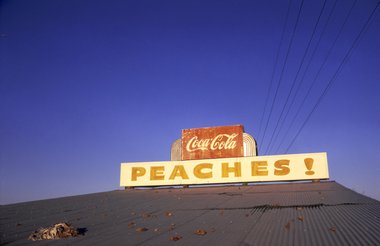
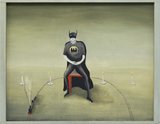

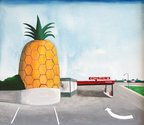
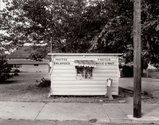
 Advertising in this column
Advertising in this column Two Rooms presents a program of residencies and projects
Two Rooms presents a program of residencies and projects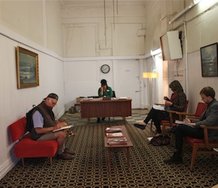
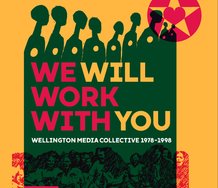
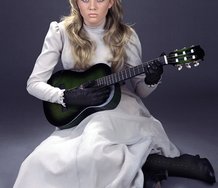
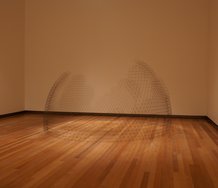
This Discussion has 0 comments.
Comment
Participate
Register to Participate.
Sign in
Sign in to an existing account.